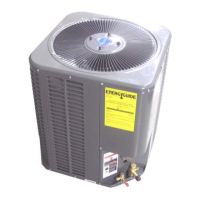Air leakage of only 3% in a return duct can cause a 5% loss in system capacity. 3% leakage on a three
Duct systems installed in the conditioned space can be left uninsulated , but a dense 1/2” fiberglass duct
liner reduces blower and air noises, and prevents sweating ducts when humidity levels are high.
Supply and return duct systems in attics and crawl spaces require a minimum 1” of dense duct liner or 2”
fiberglass wrap with a sealed vapor barrier. A leaky vapor barrier results in duct sweating, causing wet
Air supply diffusers must be selected and located carefully. They must be sized and positioned to deliver
Effective duct insulation is essential to prevent loss of capacity and sweating ducts in the cooling mode.
ton system is only 30 CFM. Two or three unsealed joints can cause a leak of this size. Sealing the return
and supply ducts result in full system capacity and lower operating costs.
Heat transfer through poorly insulated systems can result in over 50%
insulation
does not insulated.
loss in operating capacity. Sweating
ducts also results in rusting that leads to premature duct failure. Carefully follow the industry practices to
insure a well designed duct system.
treated air along the perimeter of the space. If they are too small for their intended air flow, they can be
noisy. If they are not located properly, they can cause drafts in the rooms. Return air grilles
must be
properly sized to carry air back to the blower. If they are too small they also cause noise. The installers
ensures a comfortable living space.
should balance the air distribution system to ensure proper air flow to all rooms in the home. This
! WARNING
adjustment and operation of this unit. Read these instructions thoroughly before attempting installation or
These instructions are intended as an aid to qualified, service and instalolation personnel for proper installation
service this equipment. Failure to follow these instructions may result in improper installation,
service or maintenance and could possibly result in fire, electrical shock, property damage.
.
This product is designed and manufactured to permit installation in accordance with National Codes. It is
prevailing local codes and regulations. The manufacturer assumes no responsibility for equipment
installed in violation of any codes or regulations.
The United States Environmental Protection Agency (EPA) has issued various regulations
may harm the environment and can lead to the imposition of substantial fines. Because these regulations
regarding the introduction and disposal of refrigerants from this unit. Failure to follow these regulations
the installer's responsibility to install the product in accordance with National Codes and/or
are subject to revision any repair on this unit should be done by a certified technician.
Central Air Conditioning Model: Condensing Unit, HC13-D2
7. REFRIGERANT SYSTEM DIAGRAM
8. INSTALLATION INSTRUCTIONS

